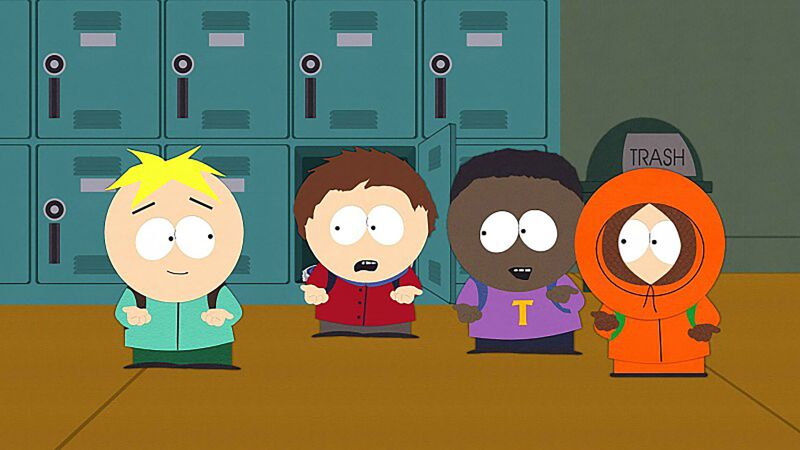Not since 69 has a number caused this much disruption.
“6-7,” pronounced “six-seveeeeen,” is haunting school halls across the country (including South Park Elementary), making it the Gen Alpha nonsense phrase of the moment. Kids are shouting it in classrooms when a teacher turns to page 67, when lunchtime is 6 to 7 minutes away or for no reason at all.
“It’s like a plague — a virus that has taken over these kids’ minds,” said Gabe Dannenbring, a seventh-grade science teacher in Sioux Falls, South Dakota. “You can’t say any iteration of the numbers 6 or 7 without having at least 15 kids yell, ‘6-7!’”
It’s a joke without a punchline (or a setup, for that matter). 6-7 means nothing, but using it can make a student feel like a member of a bigger, cooler group of their peers.
“It becomes a language game to them that, it would seem, only folks in their group know how to play,” said Gail Fairhurst, a University of Cincinnati professor who teaches leadership communication (and Gen Alpha speak).
Skibidi toilets and rizzes come and go. 6-7 is likely destined for the slang graveyard soon, now that adults are talking about it so much. But there’s something almost profound about its infinite interpretations, its refusal to be defined.
“I think that’s part of what upsets people about it, and I think that’s part of what people like about it,” said Taylor Jones, a linguist and social scientist.
There may be no coherent explanation for 6-7, but here goes anyway: The number appears in the chorus of “Doot Doot (6 7),” a viral song by the Philadelphia rapper Skrilla. (In Skrilla’s case, according to Jones, 6-7 is likely a reference to the 10-67 police code, which is often used to report a death.)
In December 2024, around the same time “Doot Doot” started taking off, high school basketball phenom Taylen Kinney appeared to create a gesture to accompany the phrase. In a clip shared by his Overtime Elite team, Kinney’s teammate asks him to rate a Starbucks drink out of 10.
“Like a 6 … 6 … 6-7,” he says, adding an indecisive gesture, as though he were weighing two options in his palms.
Shortly thereafter, Kinney started incorporating the song and gesture into his TikToks, where he has over 1 million followers.
The song started appearing in sports highlight reels, including those for Charlotte Hornets point guard LaMelo Ball. (He stands at 6 feet, 7 inches, natch.) Ball doesn’t seem annoyed by the memes yet, but the NBA season hasn’t officially started, so there’s still time.
A face of 6-7 emerged in March, when a video caught a young, overexcited spectator at an amateur basketball game shouting “6-7!” with the accompanying hand gesture. He became the embodiment of that annoying classmate who can’t stop spouting nonsense phrases. Somehow, the internet decided this stereotype’s name was Mason — and thus, Mason 67 has become another inside joke. (This “Mason” character has since become an icon of online analog horror, per Know Your Meme, but that’s another story.)
So, if a kid uses any of the above explanations when you ask what the heck 6-7 is, they’re probably right. But most kids don’t even know where it came from, Dannenbring said.
“Nobody knows what it means,” he said. “And that’s kind of the funny thing about it.”
Its meaninglessness is partly due to what Jones calls “semantic bleaching,” where a phrase is divorced from its original context and comes to mean something entirely different (or, in this case, nothing).
Using 6-7 comes down to a willingness to have fun, Jones said: “Do you have a little bit of whimsy? Or are you a party pooper?”
Sure, it’s nonsense, but 6-7 serves a critical social function. It’s a shibboleth, or a phrase that signifies that one belongs to an “in” group, Jones said. People who don’t say it or get it are on the outs. And what kid doesn’t want to belong?
“Language is a way for people to form community,” said Fairhurst. “Even if it’s a nonsense term, if they seem to know what it means, that can be a unifying force. And if somebody isn’t understanding the term, it can exclude people from that community, as well.”
6-7 has also survived longer than other internet nonsense words — even that pesky “skibidi” — likely because “grown-ups are so angry about it,” Jones said.
“The fact that you can get a big reaction from somebody for something just totally meaningless — that might give it longer longevity than it might otherwise have,” Jones said.
Fed-up teachers are banning it from their classrooms or making exasperated TikToks about the number of times they’ve heard it in a single school day (for Dannenbring, the record is 75). Shouting “6-7!” after it’s forbidden becomes a “way to show resistance,” said Fairhurst.
Teachers are now playing defense by using 6-7 themselves. A Michigan middle school choir teacher successfully staved away cries of “6-7” by incorporating it into a warmup song that also includes “slay,” “Ohio” and “rizz.”
“Don’t scream at me … even though you get excited,” the teacher begs her class before they begin chanting “6-7, 6-7, 6-7, skibidi,” a chorus of little cringe cherubs.
When instructing his students to open their textbooks to page 67, Dannenbring will suddenly adopt the timbre of his enthusiastic seventh graders, who immediately protest their teacher using a phrase that does not belong to him. (At 27, Dannenbring is an elder member of Gen Z. But a young teacher is still a teacher, and, therefore, too old to play.)
“If you don’t play into it, yeah, it’s super disruptive,” Dannenbring said. “If you acknowledge it, then it gets over with in about 15 seconds.”
And if that doesn’t shut down the conversation, he said he uses it incorrectly on purpose: “‘That’s so 6-7 of you.’”
“The easiest way to kill it is for teachers to say that it’s cool,” Jones said.
Comedian Josh Pray has started using it in front of his kids, working it into his videos, desperate to reclaim a formerly innocuous number.
“I’m trying to take our numbers back!” he said. “I’ll be 67 before they know it, and I don’t want to hear that specific tone all around me as a taunt to my age!”
Fear not, parents — incessantly screaming “6-7!” is not enough to prove that your children are “brainrotting.” Concerns about literacy falling and critical thinking skills diminishing are legitimate, but they’re being “projected onto normal, youthful behavior,” Jones said.
“We’re rewriting our own history,” Jones said. “This is not anywhere near being a new phenomenon.”
Every generation invents its own slang, and language evolves in ways most of us will never consciously perceive, Jones said. Kids will always come up with cool new phrases (like “cool”!), and adults will be left scratching their heads in confusion.
Nonsense phrases like this aren’t inherently harmful, and 6-7 certainly isn’t going to bring about the end of the English language, Fairhurst said. But its popularity could be a benign symptom of our “post-truth” society, she said, where the meaning and specificity of communication matters less than people’s interpretation of it.
“It seems like it’s sort of a relative of that kind of phenomenon, where we’re just using language to use language, and not because we see something particularly meaningful or particularly real about it,” she said.
Perhaps 6-7 is already on its way out — it’s survived for nearly a year, essentially a century in TikTok time. Some of Dannenbring’s students are starting to roll their eyes when they hear their classmates yelling it. Middle school teacher and comedian Philip Lindsay said he’s already hearing potential replacements in his classroom — “41,” for one, another similarly meaningless number that makes kids inexplicably giggle.
“41 was started to try and dethrone 6-7,” Lindsay said. “6-7 just happened. 41 was pushed.”
The way Dannenbring sees it, slang can get a lot worse than 6-7. Past trends have inspired students to stick pencils into their school-issued laptops to set them on fire or rip sinks straight off the walls of their school bathrooms.
“We’ve had those words before, like Skibidi toilet,” he said. “This one is significantly less annoying.”
First Appeared on
Source link












